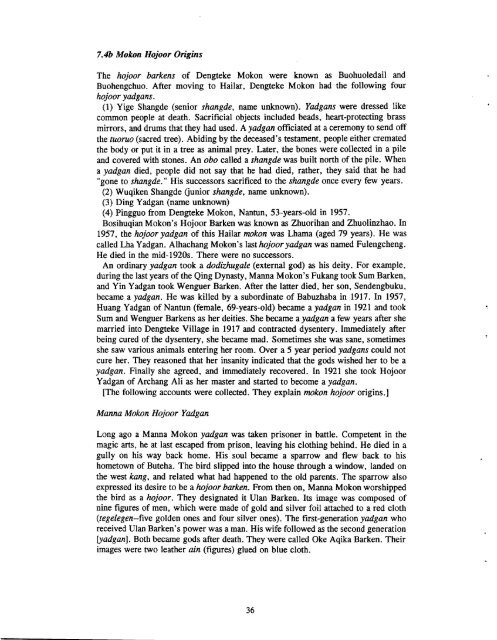China's Dagur Minority - Sino-Platonic Papers
China's Dagur Minority - Sino-Platonic Papers
China's Dagur Minority - Sino-Platonic Papers
Create successful ePaper yourself
Turn your PDF publications into a flip-book with our unique Google optimized e-Paper software.
7.4b Mokon Hojoor OriginsThe hojoor barkens of Dengteke Mokon were known as Buohuoledail andBuohengchuo. After moving to Hailar, Dengteke Mokon had the following fourhojoor yadgans.(1) Yige Shangde (senior shangde, name unknown). Yadgans were dressed likecommon people at death. Sacrificial objects included beads, heart-protecting brassmirrors, and drums that they had used. A yadgan officiated at a ceremony to send offthe memo (sacred tree). Abiding by the deceased's testament, people either crematedthe body or put it in a tree as animal prey. Later, the bones were collected in a pileand covered with stones. An obo called a shangde was built north of the pile. Whena yadgan died, people did not say that he had died, rather, they said that he had"gone to shangde." His successors sacrificed to the shangde once every few years.(2) Wuqiken Shangde (junior shangde, name unknown).(3) Ding Yadgan (name unknown)(4) Pingguo from Dengteke Mokon, Nantun, 53-years-old in 1957.Bosihuqian Mokon's Hojoor Barken was known as Zhuorihan and Zhuolinzhao. In1957, the hojoor yadgan of this Hailar mokon was Lhama (aged 79 years). He wascalled Lha Yadgan. Alhachang Mokon's last hojoor yadgan was named Fulengcheng.He died in the mid-1920s. There were no successors.An ordinary yadgan took a dodizhugale (external god) as his deity. For example,during the last years of the Qing Dynasty, Manna Mokon's Fukang took Sum Barken,and Yin Yadgan took Wenguer Barken. After the latter died, her son, Sendengbuku,became a yadgan. He was killed by a subordinate of Babuzhaba in 1917. In 1957,Huang Yadgan of Nantun (female, 69-years-old) became a yadgan in 192 1 and tookSum and Wenguer Barkens as her deities. She became a yadgan a few years after shemarried into Dengteke Village in 1917 and contracted dysentery. Immediately afterbeing cured of the dysentery, she became mad. Sometimes she was sane, sometimesshe saw various animals entering her room. Over a 5 year period yadgans could notcure her. They reasoned that her insanity indicated that the gods wished her to be ayadgan. Finally she agreed, and immediately recovered. In 1921 she took HojoorYadgan of Archang Ali as her master and started to become a yadgan.[The following accounts were collected. They explain mkon hojoor origins. ]Manna Mokon Hojoor YadganLong ago a Manna Mokon yadgan was taken prisoner in battle. Competent in themagic arts, he at last escaped from prison, leaving his clothing behind. He died in agully on his way back home. His soul became a sparrow and flew back to hishometown of Buteha. The bird slipped into the house through a window, landed onthe west kang, and related what had happened to the old parents. The sparrow alsoexpressed its desire to be a hojoor barken. From then on, Manna Mokon worshippedthe bird as a hojoor. They designated it Ulan Barken. Its image was composed ofnine figures of men, which were made of gold and silver foil attached to a red cloth(tegelegen--five golden ones and four silver ones). The first-generation yadgan whoreceived Ulan Barken's power was a man. His wife followed as the second generation[yadgan]. Both became gods after death. They were called Oke Aqika Barken. Theirimages were two leather ain (figures) glued on blue cloth.
















